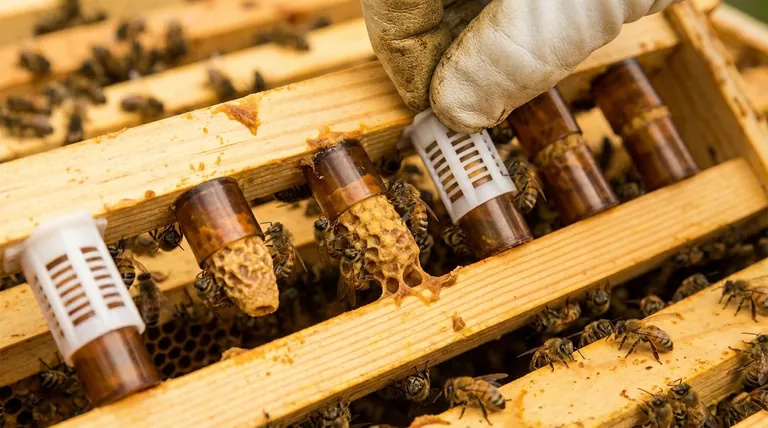In the Nicot queen rearing system, cages can be added to sealed cells at any point after they are capped. While they can be caged immediately, it is a very common and accepted practice to wait a few extra days. This delay allows the nurse bees in the colony to continue their work on the cell.
The decision of when to cage a sealed queen cell is a trade-off. You are choosing between maximizing the natural care provided by worker bees and ensuring the absolute protection and simplified management of the emerging virgin queen.

The Role of the Cell Finisher Colony
Once a queen cell is sealed, the work of the colony is not finished. Understanding this post-capping period is key to making an informed decision about when to add your cages.
Post-Capping Care
Worker bees, particularly nurse bees, continue to tend to the sealed cell. They cluster on the cell bars, providing constant warmth and regulating the temperature and humidity crucial for the pupa's development.
The "Sculpting" Process
During the days following capping, workers will extensively sculpt the cell. They add more wax, deepening the characteristic dimples and reinforcing the cell's structure, which helps with insulation and protection.
Analyzing the Timing Options
There are two primary approaches to timing the addition of cages, each with its own logic. Neither is inherently wrong; they simply serve different priorities.
Option 1: Caging Immediately After Sealing
This method prioritizes security and administrative ease. By caging the cell as soon as it is capped, you eliminate all risks of external interference.
The primary benefit is absolute protection. An early-emerging virgin queen cannot destroy the other cells, and you have a perfectly contained queen ready for her next step.
Option 2: Waiting a Few Days Before Caging
This approach, noted as common practice, prioritizes natural development. By waiting, you allow the workers to perform the post-capping care and sculpting described above.
The theorized benefit is a potentially more robust cell and queen. The extra attention and wax work from the nurse bees may contribute to a healthier development environment for the pupa inside.
Understanding the Trade-offs
Choosing when to cage a cell is less about right versus wrong and more about balancing risk with potential reward.
Safety vs. Natural Development
Caging immediately is the lowest-risk option. It is a predictable and safe method, especially for beekeepers who cannot monitor their cell builder colony daily.
Waiting a few days introduces a very small risk. If your dates are slightly off, you could have a queen emerge before you add the cages. However, it allows the bees to finish their natural process, which many experienced queen rearers value.
Practical Implications
For most beekeepers, the difference in the final quality of the queen is likely negligible. The choice often comes down to your personal beekeeping philosophy and management style. Both methods produce excellent queens when done correctly.
Making the Right Choice for Your Goal
Select your timing based on your primary objective for the queen rearing process.
- If your primary focus is maximum security and simplified management: Cage the cells on the day they are sealed to eliminate any risk of premature emergence and fighting.
- If your primary focus is mimicking natural processes for potentially more robust queens: Wait 2-4 days after the cells are sealed before adding the cages, allowing workers to provide additional care and sculpting.
- If you are new to queen rearing: Caging immediately is the safest and most straightforward approach until you are confident in your timing and observation skills.
Ultimately, both methods are widely used and successful; the best choice is the one that aligns with your specific workflow and comfort level.
Summary Table:
| Timing Option | Primary Focus | Key Benefits |
|---|---|---|
| Caging Immediately After Sealing | Maximum Security & Simplified Management | Absolute protection from premature emergence and queen fighting |
| Waiting 2-4 Days After Sealing | Mimicking Natural Processes | Allows worker bees to provide post-capping care and cell sculpting |
Ready to Optimize Your Queen Rearing Process?
Whether you're a commercial apiary focused on maximum queen yield or a distributor seeking reliable equipment for your customers, HONESTBEE has the wholesale solutions you need. Our Nicot-compatible cages and queen rearing supplies are designed for precision and durability, helping you achieve consistent results season after season.
Contact our expert team today to discuss bulk pricing and discover how our beekeeping equipment can enhance your queen production workflow.
Visual Guide

Related Products
- Brown Nicot Queen Cell Cups for Breeding Queen Bees Beekeeping
- No Grafting Queen Rearing Kit: System for Royal Jelly Production and Queen Rearing
- JZBZ Push-In Queen Cell Cups for Beekeeping
- Plastic Chinese Queen Grafting Tool for Bee Queen Rearing
- Double Head Beekeeping Grafting Tools for Beekeepers
People Also Ask
- How does Queen Rearing with JZBZ work? A Reliable System for Consistent Queen Production
- Why is it important to select a healthy larva less than 24 hours old for queen rearing? Maximize Queen Quality and Colony Strength
- What are the ideal conditions for raising good queen cells? Achieve Robust Queens with Strong Cell-Builder Colonies
- What role does the natural swarming process play in queen rearing? Harness the Swarm Instinct for Better Queens
- What should be done with extra queens from grafting? A Strategic Guide for Apiary Management



















